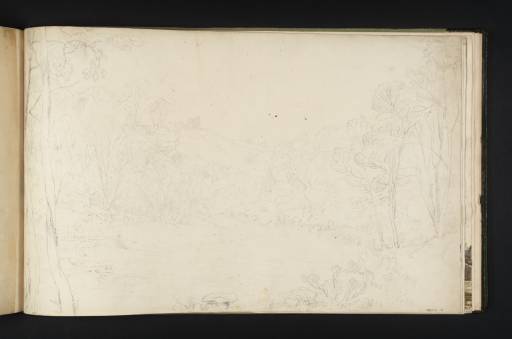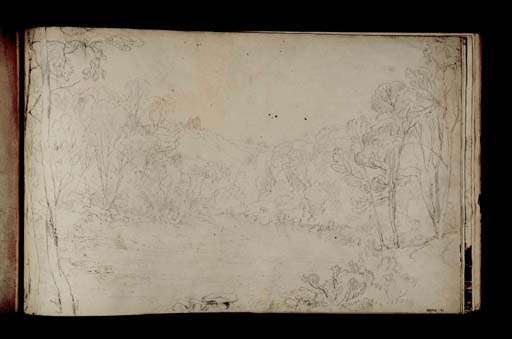Joseph Mallord William Turner On the River Ure at Hackfall, Looking South towards Mowbray Castle c.1816
Image 1 of 2
Joseph Mallord William Turner,
On the River Ure at Hackfall, Looking South towards Mowbray Castle
c.1816
Joseph Mallord William Turner 1775–1851
Folio 37 Recto:
On the River Ure at Hackfall, Looking South towards Mowbray Castle c.1816
D09053
Turner Bequest CXXVIII 37
Turner Bequest CXXVIII 37
Pencil on white wove paper, 285 x 460 mm
Inscribed by Turner in pencil ‘Clear’ (twice), ‘Black’, ‘Light’, ‘Stones’, ‘Blue’ Dark’, ‘Rock’, ‘Rocks olive’ within drawing, along river
Stamped in black ‘CXXVIII 37’ bottom right
Inscribed by Turner in pencil ‘Clear’ (twice), ‘Black’, ‘Light’, ‘Stones’, ‘Blue’ Dark’, ‘Rock’, ‘Rocks olive’ within drawing, along river
Stamped in black ‘CXXVIII 37’ bottom right
Accepted by the nation as part of the Turner Bequest 1856
Exhibition history
1879
University Galleries, Oxford, 1879 until at least 1909 (92–181).
References
1909
A.J. Finberg, A Complete Inventory of the Drawings of the Turner Bequest, London 1909, vol.I, p.360, CXXVIII 37, as ‘Mr. Ruskin’s title – “On the Greta, Mortham Tower”’.
1980
David Hill, Stanley Warburton, Mary Tussey and others, Turner in Yorkshire, exhibition catalogue, York City Art Gallery 1980, p.26, note 9; p.38, no.46.
With folio 38 from this sketchbook (D09054) this is one of two detailed studies of Hackfall on the River Ure between West Tanfield and Masham. It looks south down the Ure towards Fisher’s Hall amongst trees at the centre with Mowbray Castle on the higher ground beyond. The buildings were designed as eye-catchers for the picturesque gardens of Hackfall laid out by William Aislabie about 1750. His father, John Aislabie was responsible for the celebrated gardens at nearby Studley Royal and Fountain’s Abbey. William Fisher was their head gardener and the building near the river was named after him. Turner will have known of Hackfall through The Works of the Late Edward Dayes, published in 1805, to which he was a subscriber. Dayes had visited Hackfall on a tour of Yorkshire and Derbyshire in 1803, and devoted a distinct section of his account to its description.1
The sketch served as the basis of a studio watercolour traditionally called ‘Mowbray Lodge, Ripon’ (London, Wallace Collection)2 the first owner of which was Sir William Pilkington of Stanley Chevet, near Wakefield. Small spatters of grey-green watercolour in the sky in the sketch may have occurred as Turner worked on the watercolour. Also possibly related is a colour beginning hitherto known as Stormy Landscape. – “Hatfield (?)” (Tate D25293; Turner Bequest CCLXII 171), but while the general composition is similar, the light effect in the colour beginning is not identical to that of the watercolour, and it may be that any resemblance is coincidental.
Turner visited the area in 1816 and the Yorkshire 1 and Yorkshire 3 sketchbooks contain subjects in the vicinity (Tate D10943–D10946, D11387–D11394; Turner Bequest CXLIV 40 a–43, CXLVI 11a–16) and it seems highly probable that the subject was one of those commissioned by the publishers Longmans to illustrate Thomas Dunham Whitaker’s projected seven-volume General History of the County of York.3 The 1816 tour was made specifically to gather material for this project, and the studies in the present book appear to represent the culminating studies of his exploration of the site. This offers some suggestion that these sketches at least, and possibly the whole sketchbook, might be dated to 1816.
Verso:
Blank
David Hill
October 2009
How to cite
David Hill, ‘On the River Ure at Hackfall, Looking South towards Mowbray Castle c.1816 by Joseph Mallord William Turner’, catalogue entry, October 2009, in David Blayney Brown (ed.), J.M.W. Turner: Sketchbooks, Drawings and Watercolours, Tate Research Publication, September 2014, https://www


